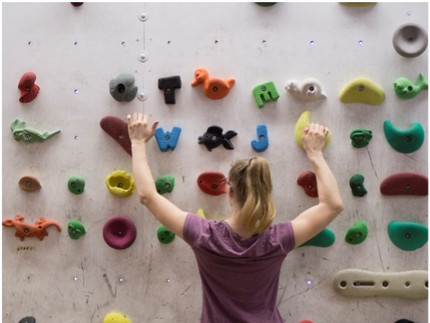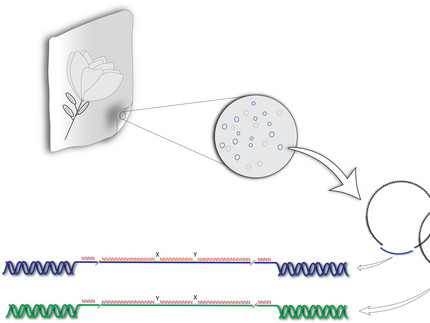Therapeutic climbing for children and young people with scoliosis
Silas Dech
Chair of Regulative Physiology and Prevention
Sport and Health Sciences
Supported within the framework of FöWiTec "Projects for the Promotion of Knowledge and Technology Transfer
Children and adolescents with scoliosis (spinal curvature) often have to put up with long waiting times until they receive therapy. Therefore, it makes sense to expand the range of therapies on offer. Climbing is also possible as a long-term therapy with motivational benefits. The "Potsdam Model" developed at the University of Potsdam offers an innovative implementation option. Initial data from a clinical study indicate a positive development through individualised climbing therapy. As a final validation step, the long-term effects are now to be researched. This will allow a scientifically sound assessment of the usefulness of establishing it in the treatment spectrum. Subsequently, the way should be prepared for a practical transfer. To this end, possibilities for the continuation of the innovative form of therapy will be examined and corresponding concepts developed so that as many children and adolescents as possible can benefit from it in the near future.
Molecular labelling system with position-oriented DNA encryption
Dr. Lena Hochrein
Research Group Molecular Biology
Institute of Biochemistry and Biology
Supported within the framework of FöWiTec "Projects for the Promotion of Knowledge and Technology Transfer"
In order to prevent brand and product piracy, the proposed project aims to experimentally validate a DNA-based molecular design that has already been developed in silico and can be incorporated into products or packaging materials as proof of authentication. The design is based on a library of DNA molecules comprising a large number (typically millions) of different DNA sequences. These sequences contain a specific pattern as a code. Put simply, this code consists of a relationship between selected positions/nucleotides in an otherwise randomised DNA sequence. The innovative design of the DNA molecules enables cost-effective production and verification of the DNA sequences, whereby the combination of coding and limitation of the quantity of DNA applied ensures a high degree of protection for a wide variety of products, e.g. pharmaceuticals, works of art or testaments, and counterfeiting can be ruled out.
Polymer and Microplastic Separation from Material Properties
Dr Marek Bekir
WG Experimental Physics
Institute for Physics and Astronomy
Supported within the framework of FöWiTec "Projects for the Promotion of Knowledge and Technology Transfer".
This research work provides a key concept for the development of a filtration device - similar to a chromatograph - for dissolved molecules or proteins. The special feature: particles and objects in the micrometre range are filtered. The device uses the advantages of microfluidics in combination with the newly discovered light-induced fluid flow technology and can be used to separate and purify micro and polymer particles with the same particle size just by the material composition. This is already possible on a laboratory scale - the system is to be further developed for commercial use as part of FöWiTec.
Smartphone-based heart rate variability biofeedback for the treatment of depression and premenstrual syndrome - A feasibility study
Dr. Julia Wendt
Chair of Emotion and Biopsychology
Structural Area Cognitive Sciences
Supported within the framework of FöWiTec "Projects for the Promotion of Knowledge and Technology Transfer".
Many women of sexually mature age suffer from physical and especially psychological complaints such as depressive moods in the days before their menstruation begins. The exact causes of these under-diagnosed and under-treated premenstrual syndromes are not well understood so far, but a connection with the autonomic nervous system, especially heart rate variability (HRV), is assumed. HRV biofeedback, which aims to systematically increase HRV, has shown reliable efficacy in reducing depressive symptoms. With the planned feasibility study we want to (1) validate the smartphone-based HRV biofeedback SDK by the company Kenkou and (2) investigate the potential efficacy of HRV biofeedback in the treatment of premenstrual syndromes.
Curating Community - Impulses in Regional Identity Formation
Dr. Paul Mellenthin
Chair of Art History
Structural Area Educational Sciences
Supported within the framework of FöWiTec "Projects for the Promotion of Knowledge and Technology Transfer".
The aim of the project is to develop an innovative exhibition and publication format that activates the potential of new impulses for regional identity formation through the participation of students at the University of Potsdam. The special approach is to involve the researchers in a practically relevant field of work and to involve the public in the research process through dialogue. With the help of a long-term cooperation between the University of Potsdam and the Kunstverein KunstHaus Potsdam e.V., access to Brandenburg's cultural heritage is to be improved and integrated into a sustainable concept for revitalising the cultural landscape in a way that attracts public attention.





